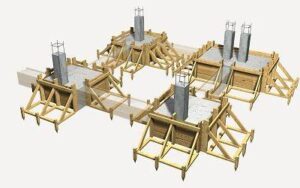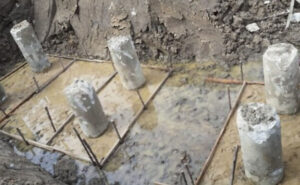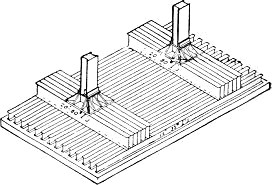There are two main types of foundations, (1) Shallow foundation, and (2) Deep Foundations. Foundation is the basic parts of the building or any other structure. It takes the load of the whole structure and transfers it to soil safely. It makes a direct impact on building stability.
In this article, we will discuss the different types of foundation and their uses. Before starting to discuss the types of foundation, we should know about what is the foundation, and what factors are affecting the choice of foundation types?
What is the foundation?
A foundation is a lower part of the building structure that transfers its gravity loads to the ground. Foundations are classified into two categories: shallow foundations and deep foundations. A tall building must have a solid foundation to last long.
Factors Affecting in choosing Types of Foundations
some factors are given below which are affecting the selection of foundation type for structure.
- Utility of structure
- Life of structure
- Height of structure
- Bearing capacity of soil
- A load of the superstructure
- Underground water table
- type of adjoining structure
- Construction material
- Location of structure
- Type of construction
- Seismic loads
Types of Foundations
Two main types of foundations are given below.
- shallow foundations
- deep foundations.
Shallow Foundation:
These types of foundations transfer the building loads to the below very close to the surface. If the depth of the foundation below 3-meter from the surface that foundation is considered a shallow foundation.
Different common types of shallow foundations are discussed below.
Isolated Foundations
This is the most widely recognized and easiest type of foundation, as this is the cheapest type of foundation. They are generally used for shallow factories to transport and spread concentrated loads caused, for example, by pillars or columns.
They are generally used for ordinary buildings. The foundations of the isolated footing type include the base directly at the base of the segment. The bases can be rectangular, square, or round. Insulated bases can comprise reinforced or non-reinforced material.
They should be used when there is no doubt that different settlements will not occur under the entire structure. The support bases are not allowed for the orientation of large loads.
It is given to reduce twisting minutes and cutting powers in their primary areas. The Foundation size can be roughly calculated by dividing the total load at the base of the column by the permissible load-bearing capacity of the ground.
The isolated diffusion base is economic when:
- The load of the structure is relatively low.
- The columns are not positioned closely.
- The bearing capacity of the soil is elevated to a reduced depth.
Strip Foundations
A Strip foundation is provided for a load-bearing wall. A strip base is also provided for a row of columns that are so close together that they overlap or almost touch each other. In such a case, it is cheaper to provide a strip stand than to provide several stands scattered in a line. A striped stand is also known as a continuous strand.
Strap Foundation
These types of foundations are formed by combining two or more columns (even with unequal loadings) into one footing. This type of foundation provides less uniform load distribution in the supporting soil.
These types of foundations are usually rectangular in shape but can be modified to a trapezoidal one to accommodate unequal column loadings.
And provided with a strap to accommodate wide column spacing or column close to property lines
Mat Foundation
The mat foundations distribute heavy loads on columns and walls in the whole area of the building. To reduce the contact pressure compared to conventional diffusion supports. The foundation of the slabs can be built near the ground surface or in the lower part of the basements. In high-rise buildings, the slab foundations can be several meters thick, with ample reinforcement to ensure a relatively uniform load transfer.
EarthBag Foundation
The basic construction method of the earthbag foundation begins by digging a trench in an undisturbed mineral subsoil. Rows of sacks (or tubes) of fabric are filled with available material. These sacks are placed in this trench and compacted with a pound about 1/3 thick pre-beaten thickness, and form a foundation. Each subsequent layer has one or more strands of barbed wire placed on top. This delves into the texture of the bag to prevent the subsequent layers from slipping and also resists any tendency to expand towards the outside of the walls.
The next row of bags is staggered by half a bag width to form a staggered pattern. These are pre-filled with material and delivered or filled on-site (often in the case of Superadobe). The weight of this bag filled with soil pushes down on the strands of barbed wire, locking the bag in position on the row below. The same process continues layer by layer, forming walls. A roof can be formed by gradually tilting the walls inward to build a dome. Traditional roof types can also be made.
Combined Foundation
The combined foundation is basically a combination of various bases, which uses the properties of different bases in a single base according to the needs of the structure. It carries two or more columns along a straight line.
Deep Foundation
A deep foundation is a type of foundation that transfers building loads to the ground farther from the ground than shallow foundations, to the underground or within a certain depth range.
The deep foundation can be used to support new or existing structures. They are connected to the structure and can be installed before the construction of the building, or they can be installed as supporting elements of the existing structure. Deep foundations are usually used for taller and heavier buildings that require greater support.
Here are some deep foundations are discussed below
Pile Foundation
These types of foundations are built by guiding the preformed units to the required foundation level or by drilling, guiding the concrete-filled pipes to the desired depth. The pipes can be filled with cement in different ways: they can be filled during or before sampling or through unlined, partially aligned, or fully aligned perforation holes before being filled with cement.
These bases are used when the soil, construction, or economic conditions make it necessary to transmit loads of layered structures that are beyond the reach of shallow foundations. In addition to the support structures, the piles can be used to help withstand lifting, tipping, and lateral forces. They are used as bases for waterfront installations, bridges, and buildings.
Also Read: Different types of Pile Foundation
Caisson Foundation
These are hollow substructures that can be built near or on the surface of the ground and are sunk to the desired level as a single unit. They have enormous load carrying capacity and are commonly used for bridges.
The caisson foundation also called the pier foundation is a water-tight structure used as a bridge pier, in the construction of concrete dams or for ship repair. It is a ready-made hollow box or cylinder that sinks to the desired depth and is then filled with concrete to form a foundation.
Basement Foundation
This hollow sub-structure provides storage or workspace beneath the surface. They were built in open excavation. Functional requirements govern the design of its structure.
Buoyancy raft foundation
The floating raft works according to a principle similar to that of a floating structure in which the support for the raft is obtained mainly by shifting the weight of the earth or by overloading the volume of a large empty base.
Drilled Shaft Foundation
These types of foundations are constructed by drilling a cylindrical hole in a deep foundation pit and then placing concrete or other prefabricated load-bearing elements in it. Their length and size can be easily customized. Drilling wells can be built near existing structures and used under low overhead conditions, so they are suitable for use in many seismic reconstruction projects. However, it may be difficult to install them under certain conditions, such as soil with boulders, soft soil, loose sand, and underwater sand.




